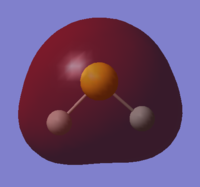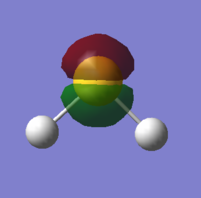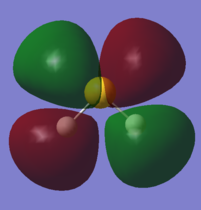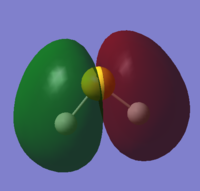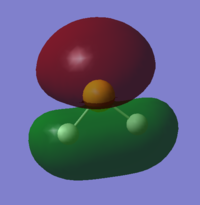Rep:Mod:01574856
NH3 Optimisation
What is the calculation method? RB3LYP
What is the basis set? 6-31G(d,p)
What is the final energy E(RB3LYP) in atomic units (au)? -56.55776873
What is the RMS gradient? 0.00000485
What is the point group of your molecule? C3V
optimised N-H bond distance and the optimised H-N-H bond angle? 1.02 & 106
Item Table
Item Value Threshold Converged? Maximum Force 0.000004 0.000450 YES RMS Force 0.000004 0.000300 YES Maximum Displacement 0.000072 0.001800 YES RMS Displacement 0.000035 0.001200 YES Predicted change in Energy=-5.986295D-10
Jmol
NH3_Molecule_01574856 |
Link to completed NH3 optimisation https://wiki.ch.ic.ac.uk/wiki/images/f/fe/TAMIM_RAHMAN_NH3_OPTIMISATION_POP.log
Display Vibrations
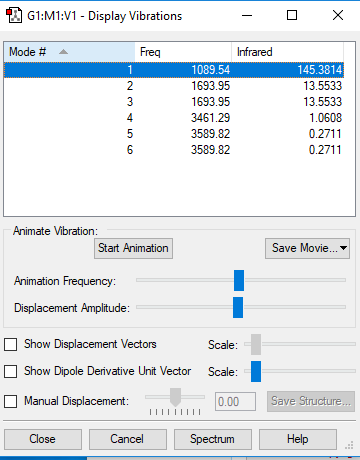
Display Vibrations Table
| Wavenumber (cm-1) | 1090 | 1694 | 1694 | 3461 | 3590 | 3590 |
|---|---|---|---|---|---|---|
| Symmetry | A1 | E | E | A1 | E | E |
| Intensity (a.u.) | 145 | 14 | 14 | 1 | 0 | 0 |
| Images | 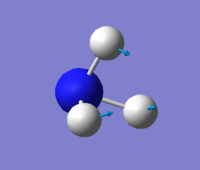 |
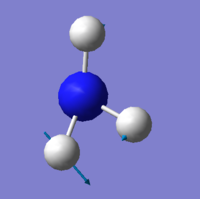 |
 |
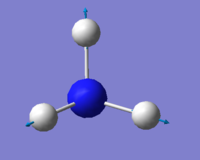 |
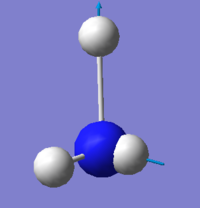 |
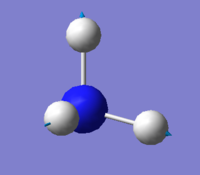 |
- How many modes do you expect from the 3N-6 rule? 6
- Which modes are degenerate (ie have the same energy)? 2&3 and 5&6
- Which modes are "bending" vibrations and which are "bond stretch" vibrations? 1,2 and 3 are bending vibrations while 4,5 and 6 are bond stretch vibrations.
- Which mode is highly symmetric? 4
- One mode is known as the "umbrella" mode, which one is this? 11
- How many bands would you expect to see in an experimental spectrum of gaseous ammonia? 3
Charge Distribution
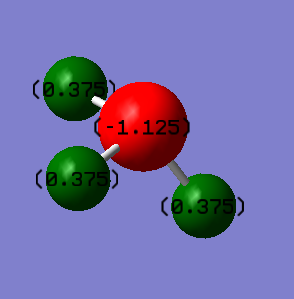
The charge on nitrogen should be slightly negative whereas the hydrogen atoms will have a slightly positive charge. This is due to the difference in electronegativity, nitrogen is more electronegative than hydrogen and therefore has a higher electron density to it leading to its slightly negative charge.
N2 Optimisation
What is the calculation method? RB3LYP
What is the basis set? 6-31G(d,p)
What is the final energy E(RB3LYP) in atomic units (au)? -109.52412868
What is the RMS gradient? 0.00000060
What is the point group of your molecule? D*H
Optimised N-N bond distance? 1.11
Item Table
Item Value Threshold Converged? Maximum Force 0.000001 0.000450 YES RMS Force 0.000001 0.000300 YES Maximum Displacement 0.000000 0.001800 YES RMS Displacement 0.000000 0.001200 YES Predicted change in Energy=-3.400972D-13
Jmol
N2_molecule |
Link to completed N2 optimisation: https://wiki.ch.ic.ac.uk/wiki/images/c/c7/TAMIM_N2_1.LOG
DIsplay Vibrations
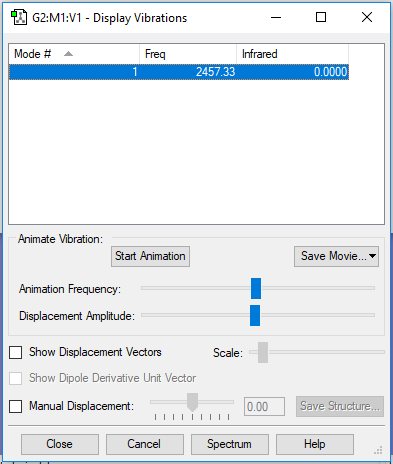
Display Vibrations Table
| Wavenumber (cm-1) | 2457 |
|---|---|
| Symmetry | SGG |
| Intensity (a.u.) | 0 |
| Images | 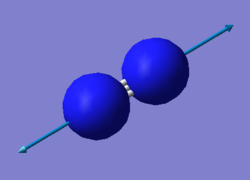 |
- How many modes do you expect from the 3N-6 rule? 0
- Which modes are "bending" vibrations and which are "bond stretch" vibrations? Only 1 bond stretching vibration
- Which mode is highly symmetric? 1
Charge Distribution
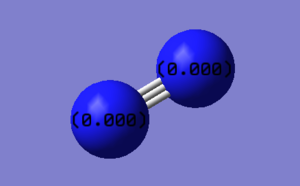
The charges on both Nitrogen atoms are zero as they have the same electronegativity which means there is no dipole in the diatomic moleule.
H2 Optimisation
What is the calculation method? RB3LYP
What is the basis set? 6-31G(d,p)
What is the final energy E(RB3LYP) in atomic units (au)? -1.17853936
What is the RMS gradient? 0.00000017
What is the point group of your molecule? D*H
Optimised H-H bond distance? 0.74
Item Table
Item Value Threshold Converged? Maximum Force 0.000000 0.000450 YES RMS Force 0.000000 0.000300 YES Maximum Displacement 0.000000 0.001800 YES RMS Displacement 0.000001 0.001200 YES Predicted change in Energy=-1.164080D-13
Jmol
h2_molecule |
Link to completed H2 optimisation: https://wiki.ch.ic.ac.uk/wiki/images/d/d4/TAMIM_H2_1.LOG
Display Vibrations
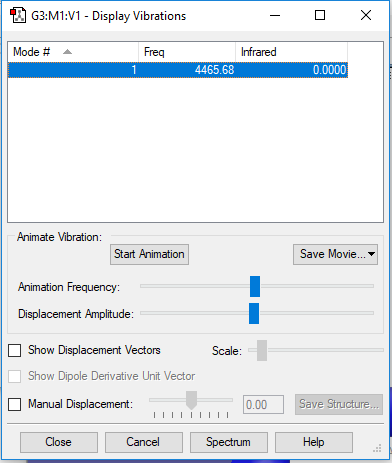
Display Vibrations Table
| Wavenumber (cm-1) | 4466 |
|---|---|
| Symmetry | SGG |
| Intensity (a.u.) | 0 |
| Images | 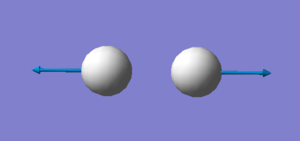 |
- How many modes do you expect from the 3N-6 rule? 0
- Which modes are "bending" vibrations and which are "bond stretch" vibrations? Only 1 bond stretching vibration
- Which mode is highly symmetric? 1
Charge Distribution
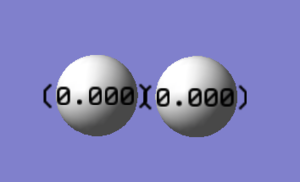
The charges on both Hydrogen atoms are zero as they have the same electronegativity which means there is no dipole in the diatomic moleule.
Mono-metallic Transition Metal Complex
The transition metal complex chosen was (dinitrogen)-(2,6-bis(1-(2,6-diisopropylphenylimino)propyl)pyridine)-iron with the reference code BARTOF.
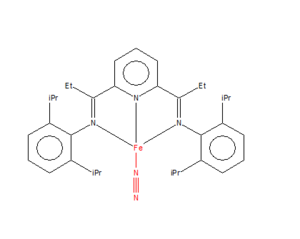
The bond length of N2 in the molecule above is slightly higher than the bond length of N2 that was calculated before (1.112 compared ot 1.1055). This is due to the lone pair of one nitrogen being donated to the central Iron atom which lowers the electron density on the nitrogen atom; this leads to less overlap of orbitals leading to a higher bond length.
Link to journal: https://pubs.acs.org/doi/10.1021/ic202750n
Haber-Bosch Process
- E(NH3) = -56.55776873
- 2*E(NH3) = -113.11553746
- E(N2) = -109.52412868
- E(H2) = -1.17853936
- 3*E(H2) = -3.53561808
- ΔE=2*E(NH3)-[E(N2)+3*E(H2)] = -0.05579076
The product ammonia is more stable than the gaseous reactants as it has a lower energy than the reactants. This means it is more stable as the forward reaction is exothermic.
Own Molecule - SH2
What is the calculation method? RB3LYP
What is the basis set? 6-31G(d,p)
What is the final energy E(RB3LYP) in atomic units (au)? -399.39162414
What is the RMS gradient? 0.00012068
What is the point group of your molecule? C2V
Bond angle of H-S-H? 92.681
Item Table
Item Value Threshold Converged?<br> Maximum Force 0.000175 0.000450 YES<br> RMS Force 0.000145 0.000300 YES<br> Maximum Displacement 0.000386 0.001800 YES<br> RMS Displacement 0.000386 0.001200 YES
Jmol
sh2_molecule |
Link to completed SH2 optimisation: https://wiki.ch.ic.ac.uk/wiki/images/f/f8/TAMIM_SH2.LOG
Display Vibrations
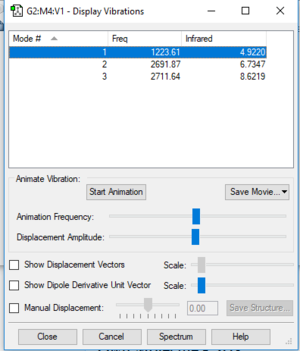
Display Vibrations Table
| Wavenumber (cm-1) | 1224 | 2692 | 2712 |
|---|---|---|---|
| Symmetry | A1 | A1 | B2 |
| Intensity | 5 | 7 | 9 |
| Images | 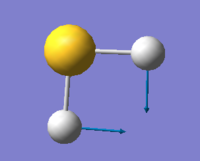 |
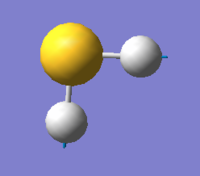 |
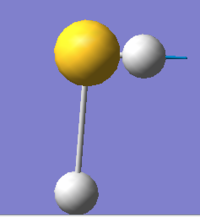 |
- How many modes do you expect from the 3N-6 rule? 3
- Which modes are "bending" vibrations and which are "bond stretch" vibrations? 1 is a bending vibration while 2 and 3 are bond stretch vibrations.
- Which mode is highly symmetric? 2
Charge Distributions
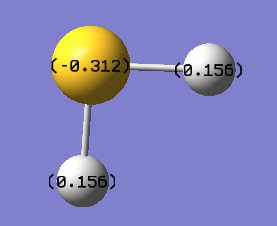
The charge on Sulfur is slightly negative whereas the hydrogen atoms have a slightly positive charge. This is due to the difference in electronegativity, sulfur is more electronegative than hydrogen and therefore has a higher electron density to it leading to its slightly negative charge.
Molecular Orbitals
Marking
Note: All grades and comments are provisional and subjecct to change until your grades are officially returned via blackboard. Please do not contact anyone about anything to do with the marking of this lab until you have recieved your grade from blackboard.
Wiki structure and presentation 1/1
Is your wiki page clear and easy to follow, with consistent formatting?
YES
Do you effectively use tables, figures and subheadings to communicate your work?
YES
NH3 0.5/1
Have you completed the calculation and given a link to the file?
YES
Have you included summary and item tables in your wiki?
YES
Have you included a 3d jmol file or an image of the finished structure?
YES
Have you included the bond lengths and angles asked for?
YES
Have you included the “display vibrations” table?
YES
Have you added a table to your wiki listing the wavenumber and intensity of each vibration?
YES
Did you do the optional extra of adding images of the vibrations?
YES
Have you included answers to the questions about vibrations and charges in the lab script?
YES, however you claimed 3 band to be visible in the real spectrum without any discussion of this number. You correctly stated that there are two sets of degenerate modes - this explains a spectrum with 4 peaks. However there are only 2 peaks visible as peaks 4, 5 and 6 are of too low an intensity to be visible.
N2 and H2 0.5/0.5
Have you completed the calculations and included all relevant information? (summary, item table, structural information, jmol image, vibrations and charges)
YES
for linear molecules the 3N-6 rules does not apply! You should have used the 3N-5 use instead!
Crystal structure comparison 0.5/0.5
Have you included a link to a structure from the CCDC that includes a coordinated N2 or H2 molecule?
YES
Have you compared your optimised bond distance to the crystal structure bond distance?
YES
Haber-Bosch reaction energy calculation 0.5/1
Have you correctly calculated the energies asked for? ΔE=2*E(NH3)-[E(N2)+3*E(H2)]
YES - however it was asked to report the energy in kJ/mol as well!
Have you reported your answers to the correct number of decimal places?
NO - calculated energies in atomic units should be quoted with 5-7 decimal places. You used 8 instead which is higher than the accuracy of the calculation.
Do your energies have the correct +/- sign?
YES
Have you answered the question, Identify which is more stable the gaseous reactants or the ammonia product?
YES
Your choice of small molecule 4.5/5
Have you completed the calculation and included all relevant information?
YES
Have you added information about MOs and charges on atoms?
You have done a good job of presenting this information, well done! You correctly stated the energies of the MOs but haven't commented if they are lying low or high in energy (are they in the HOMO-LUMO region?)
Independence 0/1
If you have finished everything else and have spare time in the lab you could: Check one of your results against the literature, or Do an extra calculation on another small molecule, or Do some deeper analysis on your results so far
NO - no independent work has bee identified

